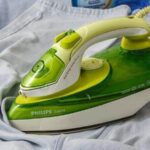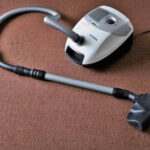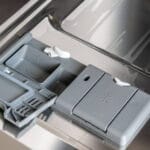Fabric softener may infuse your clothes with the aroma of mature lavender blooms, and even make them silky soft, but one thing is for sure, it can as well leave ugly stains on them. And just like other stains, fabric softener stains can bring you at your wits end after trying different stains removal methods unsuccessfully.
That being the case, this article brings together different methods for how to remove fabric softener stains.
Summary
Liquid fabric softener is hands down the best option for softening and removing static cling from your clothes. On the other hand, it can leave unsightly stains on your clothes and when this happens, you have to find an effective way to eliminate the spots.
Remove fabric softener stains with dish soap. Dish soap cuts through any greasy or oily stains with ease. Alternatively, you can use bleach, laundry detergent or unscented bar soap. How exactly to use any of these methods depends on whether you are treating an individual stain or a load marred with multiple ugly stains. Read through the article to understand each method in detail.
How to Prevent Fabric Softener Stains
Being able to remove fabric softener stains is something to be happy about. But I bet you would be happier if you didn’t have to remove them in the first place. That explains the need for preventing the unsightly marks and prints from getting to your clothes.
Avoid Using a Fabric Softener
Staining is one reason for avoiding fabric softeners but there is a plethora of other reasons as to why you should keep a safe distance. For starters, most fabric softeners contain toxic products that can be harmful to your health and the natural surroundings.
One notable chemical is chloroform benzyl acetate. This is a toxic substance that can leave you knocking multiple hospital doors from time to time. The worst thing about fabric softener chemicals is the likeliness to remain in clothes for a long time, which makes it harder for you or me to keep the possible health problems at bay.
Of course this results from the way fabric conditioners work. They leave a lubricating layer on your clothes that keeps chemicals stuck deep in the fabric fibers of your clothes.
According to scientific American prolonged exposure to fabric softeners can cause irritation in the respiratory system organs and also contribute to disorders in the central nervous system.
Secondly, fabric softeners reduce the absorbency of towels and athletic wear. This renders the items useless because they do not absorb moisture from your body. If you have been using fabric softeners on clothes, you can actually determine if this is true by observing whether your towel has become better or worse at wiping off your body over time.
Lastly, some people find the smell of fabric softeners irritating.
Do Not Pour Fabric Softener Directly on Clothes
If you have the tendency of pouring detergent or fabric conditioner directly on clothes, you are doing the wrong thing. The washer has compartments for adding detergents for a reason.
When it comes to fabric conditioner, your washer has a compartment for that. In most machines, you will see a star or flower icon on it. Put the recommended amount of softener and the machine will automatically dispense it at the right time.
If by any chance your machine does not have a dispenser, add the softener during the rinse cycle but do not pour it directly on clothes.
If handwashing clothes, add fabric conditioner in the final rinsing water. If you are washing clothes in a tub or large sink, begin by removing the clothes first. Next, fill the sink with water and add the right amount of fabric softener. Cycle the water with your hands so that the conditioner can disperse evenly in the water.
Sort Your Laundry Properly
Sometimes you might mistake marks from clothes bleeding on others for fabric softener stains. In that case, the problem arises from how you do laundry sorting. Since most of us do not learn how to do laundry correctly from anyone, it is inevitable to make mistakes.
For example, you might think that separating whites from brights is enough. However, some brights shed a lot of dye especially during the first few washes. This creates the need for washing them separately from other brights.
You can read more on separate clothes for washing in our article for how to do laundry sorting correctly.
Wash on Cold
Choose the cold water setting if your load comprises of clothes made of different colors. Unlike hot water, cold water preserves color. This prevents clothes from bleeding on each other, a challenge that can create the impression of fabric softener stains.
As added advantages, cold water it is gentler on most fabrics and it reduces the chances of wrinkling.
Inspect your Machines for Defects
As much as it seems unlikely, sometimes your washer or dryer might be responsible for the crimes you link to your fabric softener. If oil or transmission fluid is leaking from other components of your machine to the drum, you will end up with badly stained clothes. The same case applies if there is a seal rip issue.
Other possibilities include a drum that has accumulated soap scum build up from previous washes or a loose moldy gasket. Prevent these and other problems by checking your machine regularly. This allows you to fix arising problems in a timely manner.
Use the Right Detergent for a HE Washer
If you notice stains on clothes after washing them in a high efficiency machine, you are probably using the wrong detergent or too much detergent. You can only achieve peak performance when using HE detergent because regular detergent performs poorly in low water levels.
It produces too much lather and it can also leave stains that you are likely to associate with fabric softener because it is the last product that you use in the washer.
Switch to an Alternative to Liquid Fabric Softener
If you end up with stained clothes repeatedly after using liquid fabric softener, try switching to dryer sheets, dryer balls or even homemade fabric softener.
Ideally, there are 3 types of fabric softeners. These include liquid conditioner, dryer sheets and dryer balls. Liquid conditioner goes to the rinse cycle in the washer whereas dryer balls and dyer sheets release their garment softening powers in the dryer.
A more cost-effective option is to turn to your pantry basket and grab a bottle of white distilled vinegar. Pour a third cup into the washer during the rinse cycle and let it do the softening magic on your clothes. Besides improving the feel and texture, you can also bet on your clothes smelling fresh.
Do not put a lot of vinegar because its smell tends to stick on clothes even after they have dried.
Change the Fabric Softener Brand
If you experience a persistent staining problem with one fabric softener brand, it is okay to try a different one. There is no harm changing brands regularly until you get the perfect experience.
Use Less Softener
Using too much softener can lead to fabric staining. The same case applies after using too much detergent. You can know the right amount of conditioner for each load by checking the instructions written on one side of your product’s container.
Clean the Softener Dispenser
The fabric softener dispenser on your machine might dispense the conditioner haphazardly if it is clogged by product residue. Inspect and clean it before adding more softener to avoid messing up your load.
How to Remove Fabric Softener Stains

Fabric softener stains are easy to remove especially if you spot them before you dry the clothes. You only need regular laundry and stain removal products and the stains disappear from most garments after a minute of rubbing or scrubbing.
1. Use Dish Soap
Fabric conditioner stains have a lubricating effect on clothes. This makes dish soap one of the most ideal stain removers because it cuts through greasy and oily substances. Pour a few drops of dish soap on the stain and work it in a circular motion. Next, use a soft brush or your hands to scrub the stain gently. Finish up by rinsing the stain severally with clean water until it disappears.
If you have a full load with fabric softener stains all over, tackling one garment at a time might not work. Instead, run a regular laundry cycle with dish soap in the place of laundry detergent. Rinse and inspect the clothes before hanging.
2. Bleach
Bleach is an effective remedy for fabric softener stains. However, you have to begin by choosing the right kind of bleach to avoid making a bigger mess of the load you are treating.
Choose chlorine bleach if your clothes are white and oxygen bleach if your load comprises of brightly colored clothes. Stay away from this method if you intend to remove stains from a load of darks.
Mix warm water and bleach in the appropriate ratio. Generally, you need approximately a ¼ cup of bleach for a gallon of water if using chlorine bleach and about a cup of bleach for a gallon of water if using oxygen bleach.
Presoak your load for a few minutes then run it through a short wash cycle.
3. Regular Detergent
Do not underestimate regular detergent’s ability to remove annoying fabric softener stains. Even so, bear in mind that it is only super efficient when dealing with raw stains.
Fabric softener stains that have dried on the clothes are likely to take a bit of your precious time with this method. And since you have better things to do, save yourself the trouble by prioritizing any of the above two methods.
To clean laundry softener stains with regular detergent, spot treat each stain and push the detergent down the fabric fibers with a soft brush. You can use a toothbrush because its small size offers great precision.
Let the detergent sit on the stain for a few minutes and launder the garment with hands. Alternatively run the clothes through a regular cycle if dealing with a big load but do not add more detergent.
4. Use Unscented Bar Soap
A good bar soap washes clothes nice and clean and also goes a long way towards removing different kinds of stains. Begin by wetting the stain with warm water because bar soap is dry. Then rub the soap generously on the spot and use your fingers or a toothbrush to spread it properly.
Wash the stain with your hands repeatedly and rinse as needed. If the entire garment needs washing, transfer it into the washing machine and select the right wash cycle.
How to Get Fabric Softener Stains Out of Carpet
If you or someone else knocks over a bottle of fabric softener and it spills to your plush rug, natural wool or blended fibers carpet, be sure to remove the ugly marks with a quickness. Do not let the stains dry because removing them becomes a whole different story altogether.
Firstly, use paper towels or a white cloth to blot out excess. Wet the section and follow up by applying dish soap or unscented bar soap. Work the section with your fingers or a soft brush until the soap begins to lather.
Rinse repeatedly until the stain clears that use a towel to blot up excess water. Lay the carpet dry in a well ventilated place so that the spot can dry completely.
How to Remove Fabric Softener Stains from Upholstery
There is nothing to fret about if you make a mess with fabric softener on your upholstered furniture. Simply take a clean white cloth and blot out excess. Then rub a different cloth with unscented bar soap and wet it under running water.
Wring out excess water and use it to scrub the stained section repeatedly. Scrub until the stain is cleared. Rinse the cloth in the course of the processes and reapply soap as needed.
Rinse the cloth under running water until it is soap free then use it to remove excess soap from your upholstery.





